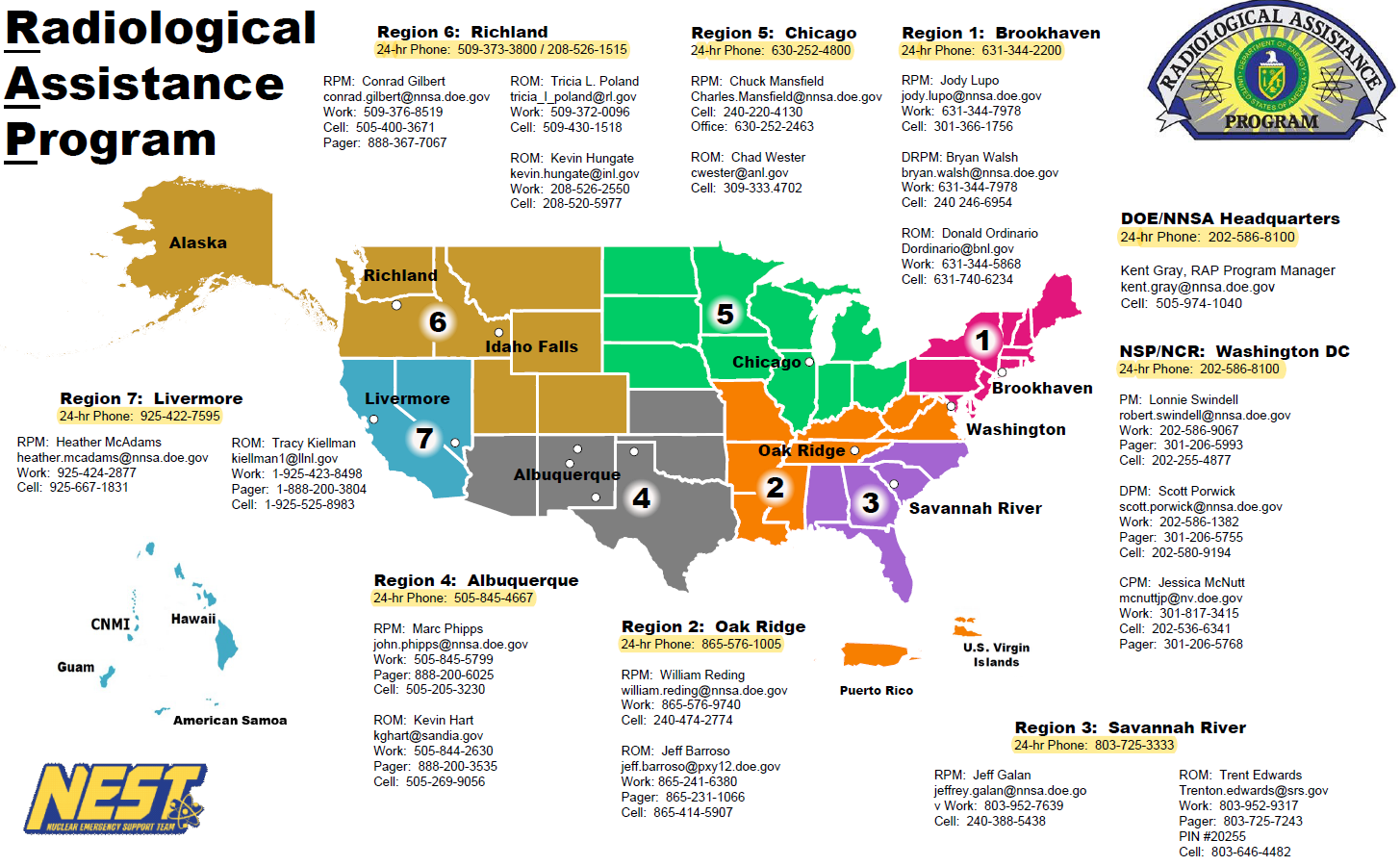
Emergency Response Assets

Consequence Management Home Team (CMHT)
The primary mission of the CMHT is to assist federal, state, tribal and local decision makers by assembling and interpreting data in order to provide for public and worker safety and minimize the social and economic impacts of a nuclear/radiological event. This includes information, technical, and operational support for the Nuclear Incident Team (NIT). CMHT support includes assembling data and populating the database, analyzing event data (e.g., monitoring data), evaluating hazards, and providing event information and data products (e.g., plume maps) to federal, state, tribal, and local agencies. The CMHT also provides a bridge line for decision makers, scientists, response teams, and state, local and tribal authorities to discuss the situation and exchange any available data.
The CMHT operates from several different laboratories, which include:
- Remote Sensing Laboratory (RSL)
- Sandia National Laboratories (SNL)
- Lawrence Livermore National Laboratory (LLNL)
- Los Alamos National Laboratory (LANL)
If requested, the CMHT can be activated to provide technical assistance to any emergency response programs or federal, state, or local deployed teams independent of a Consequence Management Response Team (CMRT) deployment.
National Atmospheric Release Advisory Center (NARAC)
The NARAC’s centralized, worldwide emergency response service provides emergency officials the information they need to rapidly respond using airborne and ground contamination projections; therefore, protecting the health and safety of the surrounding community and the environment. The Atmospheric Release Advisory Center (ARAC) is hosted in the NARAC, operated by Lawrence Livermore National Laboratory.
The NARAC’s mission is to provide timely and accurate real-time assessment advisories to emergency managers for rapid decision-making, during an emergency response involving a nuclear or chemical release. The NARAC’s computer-based system provides realistic plots and maps of radiation dose and exposure assessments, and estimates the amount of radiation contaminants released into the environment. For sites with NARAC supported direct interactive services, radiation contamination plots can be provided as soon as five minutes after the incident information is received. For non-supported sites, the time to deliver radiation contamination plots is between approximately one and two hours.
Aerial Measuring System (AMS)
The AMS provides specialized airborne radiation detection systems to provide real-time measurements of low levels of air and ground contamination. The AMS team consists of scientists, technicians, pilots, and ground support personnel. These trained experts are in charge of maintaining a state of readiness to respond to a radiological emergency at any time. The team is based out of Nellis Air Force Base in Las Vegas, Nevada, and Joint Base Andrews in Washington, D.C.
The AMS mission is to provide a rapid survey of radiation and contamination following a radiological emergency. AMS accomplishes this mission by using specially equipped aircrafts to conduct the surveys. These aircrafts are equipped to detect and measure radioactive contamination on the ground. The AMS uses a sophisticated radiation detection system to gather radiological information and store it on computers. This information is then used to produce maps of radiation exposure and contamination. This technical information is later used to determine the extent of the hazard and to decide when and where to send federal, state or local ground monitoring teams for further assessments.
Consequence Management Advance Command (CMAC)
The CMAC team consists of federal and contractor personnel who deploy directly to the local command centers established to manage the incident. The CMAC is comprised of the primary CMRT management team and tasked to establish the consequence management planning element in the site Incident Command Post (ICP) or designated incident management node where tactical planning is occurring.
The purpose of the Advance Command team is to deploy directly to the command centers overseeing the incident. If transportation options are available to transport the team ahead of the CMRT field element, or if the situation is such that the command centers are located at a considerable distance from the incident scene, a core team would be sent to those centers. The CMRT transportation options would maintain appropriate space for this core team in the event that separate travel arrangements are not in the best interest of the response.
Consequence Management Response Team (CMRT)
The CMRT consists of federal and contractor personnel to support 24-hour operations and is prepared to respond to a radiological event within six hours after notification. The response team deploys with qualified and trained personnel and an equipment package to support the technical needs of the response. The CMRT can be augmented at any time during the response with additional personnel and equipment from NNSA sites and RAP regions.
CMRT provides the base elements of a FRMAC response center, including command and control, data assessment, monitoring, health and safety, laboratory analysis, and logistical support. The CMRT deploys with consumable materials, such as personal protective equipment (PPE), to support operations for a minimum of three days. The team requires external support for lodging, food and workspace.
Radiation Emergency Assistance Center/Training Site (REAC/TS)
The REAC/TS and World Health Organization Collaborating Center, located in Oak Ridge, Tennessee, provide 24/7 radiation emergency medical support to FRMAC. Upon direction from NNSA, REAC/TS can provide deployable emergency medical and health physics support teams nationally or internationally for dose assessments, diagnosis, treatment, advice, recommendations, and consultation for all types of radiological injuries/illnesses in response to a radiological or nuclear incident. REAC/TS can provide emergency medical response to FRMAC and DOE assets personnel for injuries and/or illnesses from other hazards that might complicate a radiological or nuclear incident such as biological, chemical, thermal, or other physical events. REAC/TS can provide education and training related to radiation emergency medical response prior to, or at, radiological or nuclear incidents.
Radiological Assistance Program (RAP) Regions

Acronyms:
NCR – National Capital Region
NSP – National Search Program
RPM – Regional Program Manager
DRPM – Deputy Regional Program Manager
ROM – Regional Operations Manager
